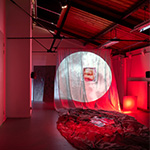NIKA Project Space is pleased to present Tacit Tongues, a group exhibition curated by Timur Zolotoev, featuring works by Buryat and Mongolian artists Mila Balzhieva, Natalia Papaeva, and Nomin Zezegmaa, alongside the Berlin-based collective Slavs and Tatars.
Opening on 25 May 2025 at NIKA’s Paris space, Tacit Tongues brings together 15 works – spanning painting, textile, video, mixed media, performance and installation – that examine the fragility and resilience of language in preserving cultural memory, reclaiming identities, and disrupting established power relations.
The exhibition responds to a legacy of adaptation and erasure experienced by cultures and languages throughout the 20th century—particularly in Mongolia and the culturally kindred Republic of Buryatia in Eastern Siberia. Informed by tacit knowledge and Indigenous approaches to storytelling, the artists use writing and reading as acts of resilience, resisting epistemic violence while offering alternative ways of understanding the world.
Tacit Tongues draws on Zolotoev’s 2024 participation in Slavs and Tatars’ year-long residency-mentorship programme in Berlin and his experience working with artists across Central Asia, Mongolia, and Buryatia, where he, Balzhieva and Papaeva are all originally from. He comments: “Language is an active site of struggle, memory, and repair – it has always served both as a tool of control and silencing, and as a vehicle for emancipation and empowerment. Mila Balzhieva, Natalia Papaeva, Slavs and Tatars, and Nomin Zezegmaa, each in their distinct way, use words, letters, and symbols to disrupt power relations, reclaim lost knowledge, and address cultural and historical traumas.”
Balzhieva draws on her Buryat heritage and Shamanic beliefs to explore how humans relate to the natural world. In her textile series Glossopteris and Latex, she imagines extinct plants as visual symbols—echoing calligraphy and ancient scripts—to suggest a lost language of the land. Through these forms, she reflects on how we record, interpret, and reshape our connection to nature.
Papaeva’s work, grounded in Buryat oral tradition, often begins with written or spoken text to create performances and installations that incorporate storytelling, singing and movement – bringing her endangered language out of the private sphere and into public view. Let me think (2025), a laser-cut text on traditional Mongolian silk fabric, is based on a piece of free writing she created in a mix of Buryat and Russian, comparing meandering thoughts to a stroll through a landscape.
The multisensory installation The Year I Decided to Become My Own Moon (2024) reimagines a Russian poem by Vsevolod Nekrasov (1934-2009), incorporating the Buryat language, humming and lunar imagery to reflect on seasonality, memory and the passage of time. Her latest work, The Mountain with a Big Nose, commissioned specially for this exhibition, sees her reclaiming the vertical Mongolian script Mongol bichig (which was replaced by Cyrillic both in Mongolia and Buryatia).
Zezegmaa’s practice explores deep time, material histories and non-human worlds, drawing from Mongolian cosmology. Body Soul Thought (2024) is inspired by a shamanic teaching, and reflects on the how the body, mind and soul align. She uses ancestral symbols and color codes drawn from Mongolian tradition—grey for paternal lineage, red for maternal—to represent the body, while a four-directional symbol stands for the soul, and a mountain landscape represents thought.
Slavs and Tatars present Kitab Kebab, an installation featuring a traditional kebab skewer pierced through a stack of the collective’s own books. The work playfully explores our relationship with reading—both intellectual and emotional—suggesting we don’t just absorb knowledge, we digest it. The unconventional reading list reflects their signature approach: blending deep scholarship with wide-ranging cultural reference. Szpagat, a sculpture of a tongue stretched into the splits, is at once humorous and sharp, capturing the contradictions of language—how it can connect and confuse, reveal and distort, all at once.
Veronika Berezina, founder of NIKA Project Space, says: “At NIKA Project Space, we are committed to supporting artists whose practices are rooted in personal histories, local languages, and cultural memory – particularly from regions that remain underrepresented in the global art landscape. We invited Timur Zolotoev, a curator from Buryatia, whose lived experience brings a depth of understanding and sensitivity that was vital to shaping a meaningful and authentic exhibition around these themes.”
The exhibition’s opening at NIKA Project Space Paris will feature a performance by Aldar Dashiev, a countertenor from Buryatia, who will interweave Buryat Mongolian vocal and instrumental traditions with a Baroque repertoire.
Press release from NIKA Project Space
Image: Natalia Papaeva. The Year I Decided to Become My Own Moon. 2024. Installation view. Photography by Sander Van Wettum. Image courtesy of the artist



